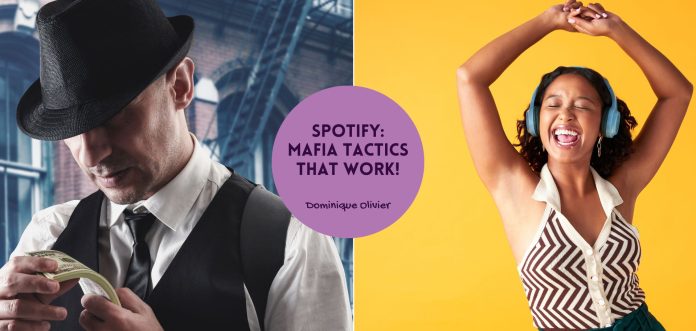What does the world’s most popular music streaming service have in common with the mob? Aside from some playlists of Italian classics, only its (very effective) conversion strategy.
Here’s a word I learned this week: pizzo. No, not pizza, although the two words do originate from the same language. The word pizzo is derived from the Sicilian pizzu, which means “beak”, and is the term commonly used to describe the money a business owner may pay to the mafia in order to stop them from breaking their windows.
After a quick Google search, I’ve just discovered that there is a South African business named Pizzo, which sells wood fired pizza ovens. I wonder how much research they did before choosing that name?
We’re familiar with this concept here in South Africa, where it’s usually referred to as “protection money”, but the source of the practice appears to be Southern Italy. In 2008, an investigation into the matter revealed that approximately 80% of businesses in Sicily were paying pizzo monthly, with amounts averaging around €457 (R8,000+) for retail traders and €578 (R11,000+) for hotels and restaurants. Construction companies were hit the hardest, with some paying upwards of €2,000 (R38,000+) per month to protect their building sites.
For me, the ultimate irony of the whole pizzo story is the “protection” angle of the pitch. Mafiosos are essentially suggesting to business owners that paying them a monthly fee will afford them and their businesses protection from criminals. Business owners who refuse to pay the pizzo have their windows smashed and/or their shops burned down by the very same gangsters who were promising them protection. So at the end of the day, the only threats that the business owners ever needed protection against were the mafiosos themselves.
Is it illegal? Without a doubt. Unethical? Completely. But is it also a textbook example of a business profiting by solving a problem it created? Absolutely.
I can think of one business in particular that found a way to monetise the pizzo concept in a completely legal way. Can you guess which one it is?
Pay for Premium, or else
It’s Spotify, dear reader.
I understand that I’m making light of a real criminal problem, and by no means am I suggesting that extortion is a joke. But isn’t there an echo of this concept in Spotify’s strategy to convert Free users to Premium? Has anyone else noticed that 80% of the ads that interrupt a listener’s enjoyment of the Free service are ads for Spotify’s own Premium service? Can’t you just hear that hammed-up-Hollywood mafioso drawl, saying “Nice playlist you got there. Be a shame if someone put an unskippable ad for Spotify Premium in it”?
It may be devious, but there’s also no question that it’s effective. Yours truly is a prime example: I held out on Spotify Free for years before converting to Premium. The straw that broke the camel’s back in my case was a particular ASMR-inspired Spotify ad that was delivered entirely in breathy whispers and made me want to roll my car every time it came on.
The numbers confirm that I’m not alone: as of 2019, Spotify has a conversion rate of 46%, meaning almost half of its users opt to make the change from Free to Premium. Not only are they converting, but they’re hanging around too. The churn rate for the Premium service is almost laughably low at 4.6%, which means that 95.4% of Spotify Premium subscribers are retained over the period being measured for churn.
Let me assure you that this is not the case across the board for freemium business models. Inspired by the success of the likes of Spotify, many founders have launched as-a-service businesses and been terribly disappointed by the outcome. Consider this far more sobering set of numbers: Evernote has a conversion rate of 4%, as does Dropbox. Google Drive barely manages to convert 0.5% of its users to paid subscribers. Unsurprisingly, the benchmark for freemium conversion is set between 1% and 10%. Now work out the cost of building the freemium audience that you need to try and convert and you can quickly see where the venture capital money goes.
Is the solution for Google Drive to start showing users unskippable ads before they can access their docs, or is there more to Spotify’s strategy than meets the eye?
Do we really hate ads this much?
Nobody likes having their dinner party playlist or carpool karaoke session interrupted by an ad. But as annoying as those ads are, is it worth paying almost R70 a month (R840 a year!) just to make them go away? What else is there that makes Premium so different?
The answer is: not that much. And therein may lie the secret to Spotify’s conversion success. The differences between the Free and Premium versions are small but deeply annoying, meaning Free users get an almost-perfect product and a daily taste of how it could be better.
For starters, Free and Premium users get practically the same access to Spotify’s entire collection of over 100 million songs and 6 million podcasts. The difference lies in how they get to access the content. While Free users get unlimited streaming, they have to put up with the aforementioned ads, plus they can only access their music when they’re online (offline listening is reserved for Premium users).
Then there’s the issue of shuffling and skipping. Free users don’t have the option of selecting a particular song to listen to – if you were to search for Queen’s Bohemian Rhapsody, for example, the nearest that Spotify Free can get you is the opportunity to shuffle through Queen’s entire discography, hoping that you land on Bohemian Rhapsody at some point in the next three hours. You need to land on it soon too, since you’re only given 6 skips per hour on the Free service – after that, you’re at the mercy of listening to whatever plays next, whether you want to or not.
There’s something to be said for a business that understands how to weaponise a slightly-annoying user experience in such a way that it converts users upward instead of chasing them away. I’m still picturing those mafiosos, but I respect the results.
If you need final convincing that ads themselves may not be the main reason, consider that Netflix is making a fortune from its ad-supported tier. Many subscribers are happy to be served ads in exchange for a cheaper way to access their favourite shows on Netflix. I wrote about the Netflix Originals content strategy last week in this column.
A war of attrition
Still, Spotify’s conversion success remains something of a mystery – after all, if the formula was obvious, every freemium business would be replicating it. But in my opinion, those small, deliberate inconveniences seem to play a role. By giving Free users an experience that’s just good enough to keep them engaged but frustrating enough to make Premium feel like a necessity, Spotify has perfected the art of nudging users toward the upgrade. It’s a fine line between irritation and persuasion, and Spotify walks it masterfully.
About the author: Dominique Olivier

Dominique Olivier is the founder of human.writer, where she uses her love of storytelling and ideation to help brands solve problems.
She is a weekly columnist in Ghost Mail and collaborates with The Finance Ghost on Ghost Mail Weekender, a Sunday publication designed to help you be more interesting.
Dominique can be reached on LinkedIn here.





Could it not also have something to do with the power of music?
I love this article as it peels back the curtain of large industry and makes me wonder how much of my behaviour am I actually in control of and how much of it is influenced through a strategic nudge by large companies? I would offer though that at least some of Spotify’s successful conversion strategy can be attributed to the fact there aren’t many streaming alternatives; Apple Music being the only one I’m aware of and it pales in comparison to Spotify.
On a separate note, I’d pay a small premium if it meant municipal services were delivered as efficiently as Spotify’s Premium streaming services! Oh wait… Aren’t those called taxes?
Thanks for the thought-provoking article on a very grating topic 😅
If Spotify hogs the ad slots with their own ads, it suggests that ads bring in far less than R70 per month per average Free user and that the ad-supported income stream is therefore not really sustainable on its own.
The numbers bear this out. Let’s look at the 2023 results:
– Subscribers: 220M premium, 320M ad-supported (an average)
– Revenue: €11.6B premium, €1.7B ad-supported
So that year the average premium user coughed up €53, but the ad-supported user only brought in €5, or a tenth of that. So even if the 80% Spotify goads were replaced by proper ads, the free tier would only bring in €25 per person. No wonder they went for this strategy.
I do find the strategy a tad *too* clever though, bordering on dishonest… I grew up with TV and radio ads, where there is a tacit agreement that I will tolerate shouty folks punting washing powder and insurance, sometimes even in an entertaining way, in return for free programming. Over time my brain has become adept at tuning those ads out.
But a voice telling me to do something I explicitly don’t want to do, over and over? What if I’m happy with the ads? Just play the ads already 😅 I think the 20% real ads are just there so that they can call it “ad-supported” instead of the “premium waiting room”. Cleverly, the Spotify website doesn’t even mention ads in relation to Spotify Free. It just states that “It’s free. No credit card required.”
So I think you are onto something with your analysis 😁
Then again, I’m on Apple Music, where I just skipped the racket and coughed up from the start 😂
Coming back to this…
I wonder what the Mean Time Before Cracking (MTBC) is for Spotify Free users. That would be an interesting distribution and one readily available to Spotify data scientists. I’m guessing your data point is far on the tail end, Dominique 😁
There is so much more Spotify can do with this data.
If a person passes the MTBC, I would eventually tune down the intimidation and just play 100% ads, thereby improving the income from a Free lifer from €5 to €25 per year. That’s maybe an extra €4B a year.
It might also make sense to run intimidation campaigns every now and then by dialling back the ads occasionally, instead of a constant barrage.
The next thing I’d do is look at the songs that folks were listening to just before they converted. Songs can be a proxy for emotional state: a great asset for any retailer. Maybe Spotify can identify moments in time when folks are more amenable to intimidation, sorry, persuasion?
Just thinking out loud… 😅